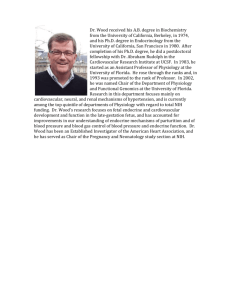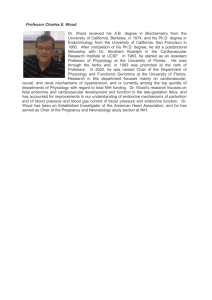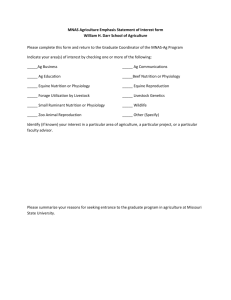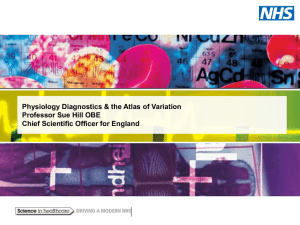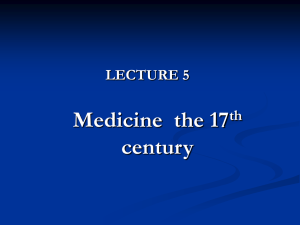Quality Assurance and Accreditation Project (QAAP)
advertisement
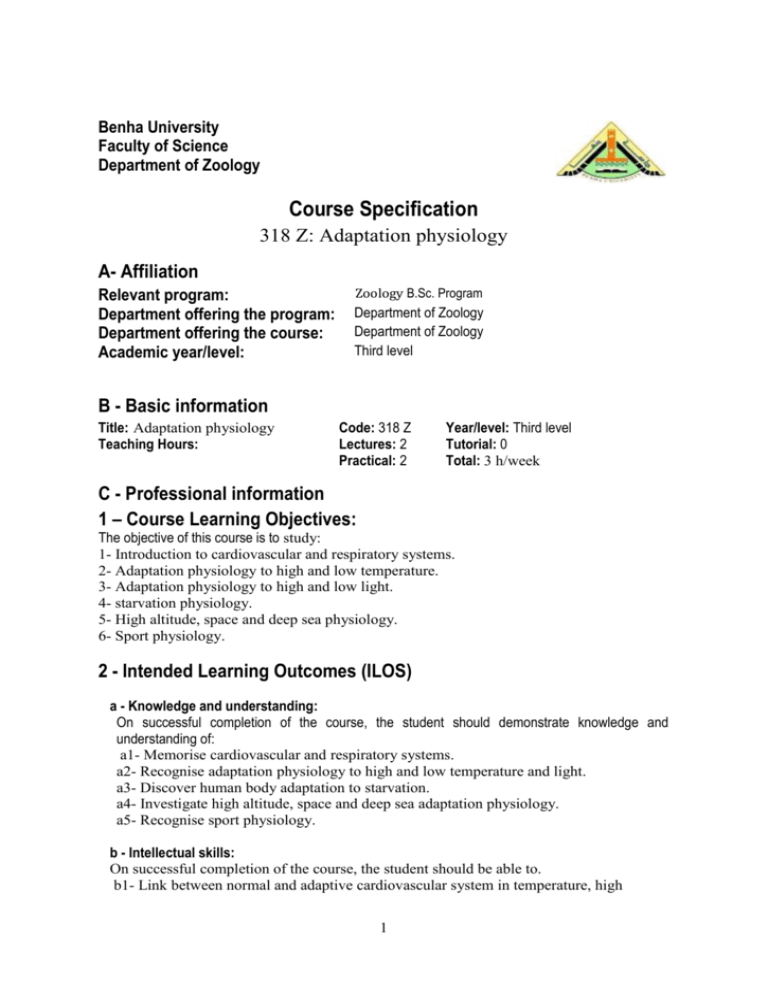
Benha University Faculty of Science Department of Zoology Course Specification 318 Z: Adaptation physiology A- Affiliation Relevant program: Department offering the program: Department offering the course: Academic year/level: Zoology B.Sc. Program Department of Zoology Department of Zoology Third level B - Basic information Title: Adaptation physiology Teaching Hours: Code: 318 Z Lectures: 2 Practical: 2 Year/level: Third level Tutorial: 0 Total: 3 h/week C - Professional information 1 – Course Learning Objectives: The objective of this course is to study: 1- Introduction to cardiovascular and respiratory systems. 2- Adaptation physiology to high and low temperature. 3- Adaptation physiology to high and low light. 4- starvation physiology. 5- High altitude, space and deep sea physiology. 6- Sport physiology. 2 - Intended Learning Outcomes (ILOS) a - Knowledge and understanding: On successful completion of the course, the student should demonstrate knowledge and understanding of: a1- Memorise cardiovascular and respiratory systems. a2- Recognise adaptation physiology to high and low temperature and light. a3- Discover human body adaptation to starvation. a4- Investigate high altitude, space and deep sea adaptation physiology. a5- Recognise sport physiology. b - Intellectual skills: On successful completion of the course, the student should be able to. b1- Link between normal and adaptive cardiovascular system in temperature, high 1 altitude, space and deep sea and sport. b2- Interpert physiological adaptation to high and low light. b3- Combine between endocrinology and light adaptation. b4- Compare between normal and adaptive respiratory system in temperature, high altitude, space and deep sea and sport. c - Practical and professional skills: On successful completion of the course, the student should be able to: c1- Count red blood cells. c2- Detect hematocrit value. c3- Draw cardiac muscle. c4- Dissect heart of fog. c5- Explain electrocardiogram (ECG). d - General skills: On successful completion of the course, the student should be able to: d1. Use information and communication technology effectively. d2. Work in a team effectively, manage time, collaborate and communicate with others positively. d3. Exhibit the sense of beauty and neatness. d4- Search for information and engage in life-long self learning discipline. 3 - Contents Lecture topics Lecture hours 2 1. Introduction to cardiovascular y system. 2. Introduction to respiratory systems. 2 3. Adaptation physiology to high temperature. 2 4. Adaptation physiology to low temperature. 2 5. Adaptation physiology to high light. 2 6. Adaptation physiology to low light. 2 7. High altitude physiology. 2 8. Space physiology. 2 9. Deep sea physiology. 4 10. 11. 12. 13. Effect of sport on cardiovacular system. Effect of sport on respiratory system. Starvation physiology. Seminar 14. Revision 2 2 2 2 2 2 a5 Intellectual Skills b1 b2 b3 b4 Practical and professional skills c1 c2 c3 c4 c5 General Skills d1 d2 d3 d4 Use information and communication technology effectively. Work in a team effectively, manage time, collaborate and communicate with others positively. Exhibit the sense of beauty and neatness. Search for information and engage in life-long self learning discipline. 3 Brain storming a4 Problem solving a3 Practical a2 Memorise cardiovascular and respiratory systems. Recognise adaptation physiology to high and low temperature and light. Discover human body adaptation to starvation. Investigate high altitude, space and deep sea adaptation physiology. Recognise sport physiology. Link between normal and adaptive cardiovascular system in temperature, high altitude, space and deep sea and sport. Interpert physiological adaptation to high and low light. Combine between endocrinology and light adaptation. Link between normal and adaptive respiratory system in temperature, high altitude, space and deep sea and sport. Count red blood cells. Detect hematocrit value. Draw cardiac muscle. Dissect heart of fog. Explain electrocardiogram (ECG). Discussions & Seminars Knowledge & Understanding a1 Presentations & Movies Intended Learning Outcomes Lecture 4 - Teaching and Learning methods: x x x 0 x x x 0 x 0 0 x x 0 x 0 0 x x 0 x 0 0 x x 0 x 0 0 x x 0 x 0 x x x 0 x 0 x x x 0 x 0 x x x 0 x 0 x x 0 0 0 0 0 0 0 0 0 0 0 0 0 0 0 x x x x x 0 0 0 0 0 0 0 0 0 0 0 0 0 0 x x 0 0 0 x x x x x x 0 0 0 0 0 0 0 x x 5- Students’ Assessment Methods and Grading: Tools: Semester Work and Mid-Term Exam Oral exam Practical exams Written exam To Measure a1 to a5, b1 to b4, and d1 to d4 Time schedule Biweekly Grading 12 % a1 to a5 and b1 to b4 c1 to c5 and b1 to b4. a1 to a5 and b1 to b4 Total Fifteenth week Fourteenth week Sixteenth week 10 % 30 % 48 % 100 % 6- List of references: 6-1 Course notes Non 6-2 Required books - Guyton, A.C. and Hall, J.E. (2006): Textbook of Medical Physiology.11th Ed. Elsevier Inc. Philadelphia.Chapter 43 and 44. -Harvey, R.A. and Ferrier, D.R. (2011): Lippincotts Illustrated Reviews: Biochemistry, North American Edition. 5th Ed, JB Lippincott, Philadelphia. Chapter 24. 6-3 Recommended books - Davenport, J. (1992): Animal life at low temperature. London: Chapman & Hall - Campbell, N. A.; Reece, J. B.; et al. (2002): Biology. 6thEd. Benjamin/Cummings. - Davenport, J. (1992): Animal life at low temperature. Chapman & Hall, London 6-4 Periodicals, Web sites, etc. www.shmoop.com/animal-movement/temperature-regulation.html www.boundless.com/biology/homeostasis/thermoregulatory-processes/modes-of-thermoregulation/ www.rinconmedico.org 7- Facilities required for teaching and learning: Physiology Lab. Chemicals and samples. Using of slit overhead projector Using a black board Group Discussions Data show Course coordinator: Head of the Department: Date: Dr. Marwa atef elewa abdelmaksoud Dr. Doaa Sabry Ibrahim Prof. Dr. Salwa Ebrahem Abd-El Hady 2015 / 2016 4
